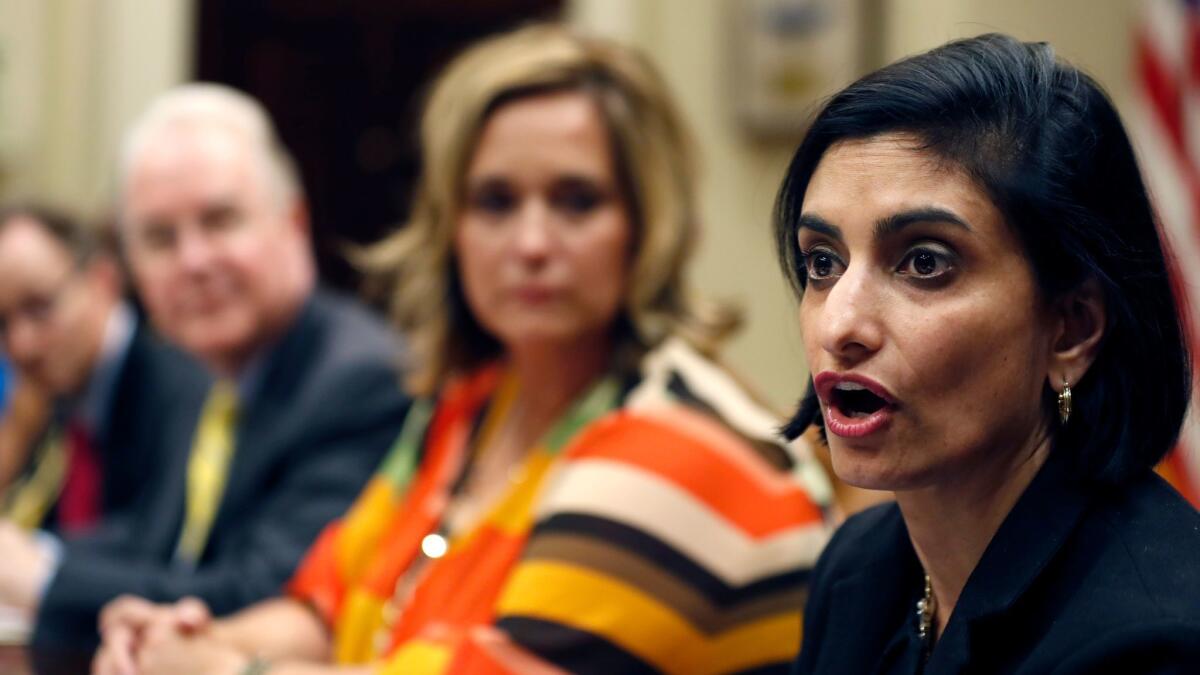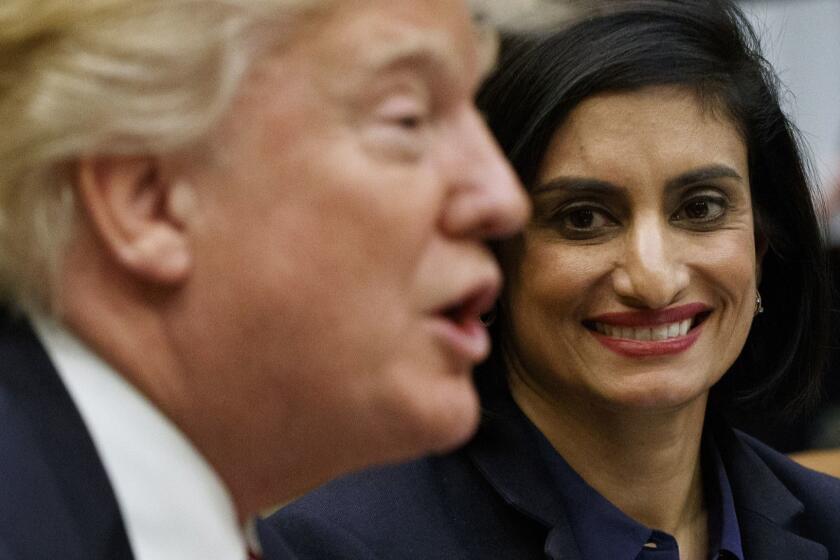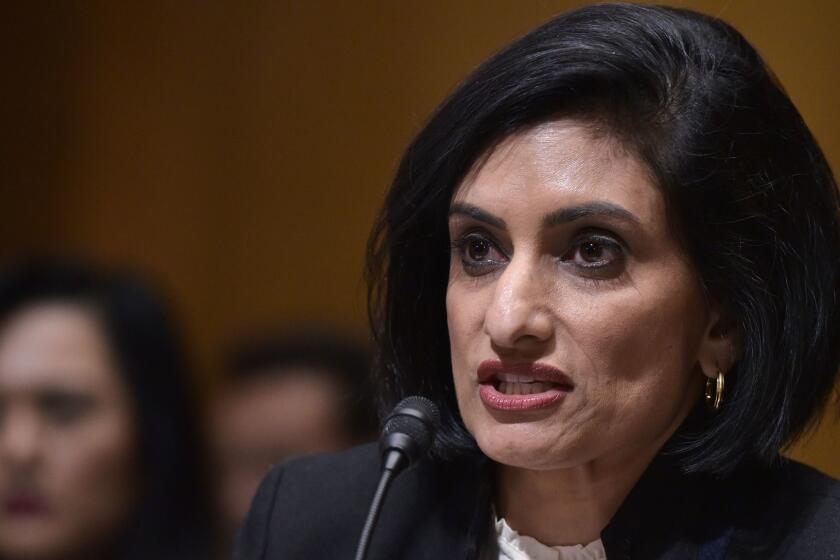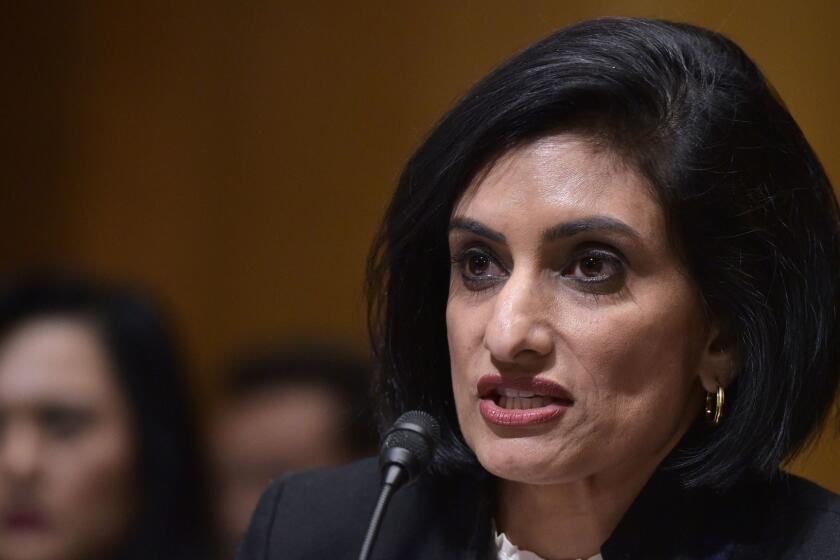Column: Seema Verma, our awful Medicare boss, spent lavishly to burnish her public image

- Share via
As the federal official in charge of Medicare and Medicaid, Seema Verma has made it her business to undermine those important public programs at almost every turn.
Those efforts, it’s now clear, didn’t come cheap: A report issued Thursday by Democrats on four congressional committees documents how Verma spent nearly $6 million of taxpayer funds on “handpicked” private consultants hired for work that included “boosting her public profile and personal brand.”
The consultants’ work included soliciting puff pieces about Verma from glossy magazines and placing obviously ghostwritten op-ed bearing her byline with major news organizations, including the Washington Post.
The Girls’ Night events are routinely hosted by well-respected journalists...to honor significant accomplishments of both Democratic and Republican women.
— USA Today defends its reporter’s hosting of a PR event for Seema Verma
One consultant, following through on her “executive visibility proposal” to “highlight and promote Seema Verma leadership and accomplishment,” arranged a “girls night in her honor” in November 2018 at the home of Susan Page, the Washington bureau chief of USA Today.
The consultant, Pam Stevens, charged the government almost $3,000 for that arrangement, according to the report, although USA Today says that Page paid for the soiree out of her own pocket.
Page has been designated the moderator of the upcoming vice presidential event between Mike Pence and Kamala Harris, though her involvement in the Verma event has prompted some calls that she withdraw.
That points to the most telling and disturbing aspect of Verma’s personal publicity campaign: The complicity of Washington’s journalistic power structure in burnishing the reputation of public officials who deserve to be pilloried for their performance, not honored for their “leadership.”
Before we delve deeper into that issue, some further details from the congressional report. We should note at the outset that the Trump administration is brushing it off. Michael Caputo, the political operative serving as spokesman for the Department of Health and Human Services, to which Verma reports, called it “a reckless, politically timed, drive-by hit job on a reform-driven Trump administration official.”
Seema Verma, the federal official in charge of Medicare, Medicaid and the Affordable Care Act, has blasted into the limelight. And not in a good way.
As director of the Centers for Medicare and Medicaid Services, Verma oversees those programs as well as the federal implementation of the Affordable Care Act. She came to her federal position thanks to Vice President Mike Pence, who she served as a healthcare advisor when he was governor of Indiana.
In that role, Verma had helped craft a state Medicaid program that limited enrollment of childless adults and imposed deductibles for the first time. The Healthy Indiana Plan, Physicians for a National Health Program wrote, “forced impoverished Medicaid enrollees to pay dearly for care, imposing unprecedented co-payments and premiums on people with little chance of affording them.”
Throughout her federal tenure, Verma has worked assiduously against the interests of those public programs and its millions of beneficiaries, generally with an overtly partisan approach. As we’ve reported, she has gone on the road attacking the ACA, which she is sworn to uphold, often using inaccurate or cherry-picked assertions about premium increases.
She worked from talking points stating that the ACA is in “a death spiral” and that “Obamacare has failed” — talking points drafted by her private consultants, according to documents cited by the congressional report.
She has also attacked “Medicare for all,” which encompasses the universal single-payer proposals of several leading candidates for the Democratic nomination for president. In public speeches she has labeled Medicare for all and related proposals for the public option for healthcare “socialist” or “radical socialist” ideas.
Verma’s most dangerous campaign has been aimed at Medicaid, the federal-state health program that is the largest such government program, serving 75 million Americans.
She has been the point person in the Trump administration’s efforts to impose work requirements on Medicaid enrollees, despite incontrovertible evidence that those programs don’t accomplish anything but throw needy people off the Medicaid rolls.
It’s been well documented that the Trump White House has filled federal agencies with bureaucrats whose life work is destroying the very agencies they’ve been assigned to.
The effort so far has come to naught, as federal courts have blocked work requirements in Arkansas and other states that have implemented or proposed them.
If you’re unaware of this aspect of Verma’s performance, that might be due to the work of the personal consultants identified by the congressional investigators. (Their investigation initially followed the blueprint of Dan Diamond and Adam Cancryn of Politico, who have expertly birddogged Verma’s spending since early last year.)
The congressional report found that Verma’s team, who generally had strong Republican ties, functioned as a “shadow” communications office at CMS aimed not at disseminating news about the agency but placing PR for Verma.
Amusingly, she had to place one, Marcus Barlow, on her shadow payroll because the White House had rejected her plan to make him the official spokesman for CMS. Its reason: He had publicly criticized Trump during the presidential campaign. Once hired, Barlow charged the government at a rate that was more than twice the $179,700 salary of the top CMS communications official, the investigators found.
The work of Verma’s team bore fruit, with TV appearances and admiring profile pieces in magazines. Then there’s the “girls night” event at the home of USA Today‘s Page, which suggests how the Washington press corps can be diverted into treating public officials as personalities rather than shepherds of public policy.
I reached out to Page for comment and promptly heard back from a USA Today spokeswoman, who told me that Page personally paid for the catering tab of more than $4,025 for the event and wasn’t aware that Stevens had submitted her own $2,933 bill to the government.
The spokeswoman, Chrissy Terrell, said “the Girls’ Night events are routinely hosted by well-respected journalists ... to honor significant accomplishments of both Democratic and Republican women.”
Seema Verma, an Indiana health consultant and bureaucrat nominated by President Trump to run Medicare, Medicaid and the Affordable Care Act, put in a word for individual choice on health insurance benefits during her confirmation hearing last week.
Terrell said this event was scheduled “in honor of two women who had recently gotten significant appointments, Heather Wilson to head the Air Force and Seema Verma to head the Centers for Medicare and Medicaid Services — both milestone moments to be recognized.”
Why Verma’s appointment to CMS was a “milestone moment” is hard to fathom. She wasn’t the first woman named to run CMS, but the fifth in a string that dates back to the appointment of Carolyne K. Davis as head of the Health Care Finance Administration, the predecessor agency of CMS, in 1981.
Nor is Verma the highest-ranking federal healthcare official ever — six women have been secretaries of Health and Human Services or of its predecessor, the Department of Health, Education and Welfare, dating back to the very first HEW Secretary, Oveta Culp Hobby, appointed by President Eisenhower in 1953.
I asked Terrell to be more specific but haven’t heard back.
What’s really going on here is an old tradition in which Washington journalists and public officials develop personal relationships that work against the public interest. Close sourcing may be valuable, but it can morph into chumminess. The great progressive watchdog I.F. Stone got it exactly right.
“All these private meetings are bad,” Stone said during an interview with Dick Cavett, “because they take the reporter into the family. Once you’d had dinner with the Secretary of State and he’s asked your opinion about a complex problem and you’ve told him what they ought to do, you feel like a statesman and a close friend, and you wouldn’t think of criticizing the great man.” (The interview was part of a great documentary, “I.F. Stone’s Weekly,” which can be seen here.)
Another practice highlighted by the congressional report is the placement of ghostwritten op-eds, under the bylines of political leaders, in prominent places. The report details the placement of op-eds in Verma’s name in the Washington Post in June 2017 and February 2018. They promoted Trump administration policies that would effectively cut funding or enrollment in Medicaid.
This practice of allowing politicians or public officials to place their names on manifestly ghostwritten articles should be eradicated from the face of the Earth. I don’t mean to pick on the Washington Post here; the practice is widespread, tolerated by newspapers and other news sources coast to coast.
Such coziness and indulgence does nothing to serve the public interest. Verma’s publicity campaign may be an extreme case, but unfortunately it’s not unique.
More to Read
Inside the business of entertainment
The Wide Shot brings you news, analysis and insights on everything from streaming wars to production — and what it all means for the future.
You may occasionally receive promotional content from the Los Angeles Times.











